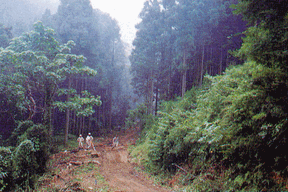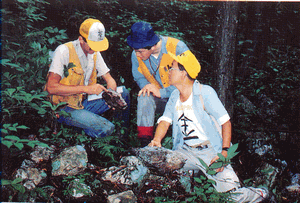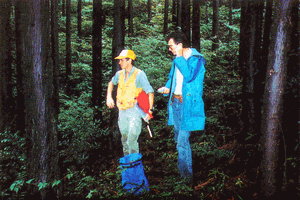

Forestry road access to old workings in the Uragami sector.Togi prospect,Honshu.
富来生神地区の古い坑道に通じる林道
NICA's Togi prospect is located on the Noto Peninsula on the western side of Honshu.
It is in the same general geological province as the old Sado mine ,which produced 2.5million ounces of gold and 74 million ounces of silver from epithermal fissure veins.
Sado was discovered in the seventeenth century and lies on the northern flank of a graben marked by a pronounced gravity anomaly.
The Togi prospect also lies on the northern flank of a grabern similar in style to, and with the same orientation as the Sado regional structure.
The prospect consists of a series of fissure veins which can be traced by numerous old and mostly shallow workings ,and by float derived from such veins ,over an aggregate strike length of seven kilometres.
The Togi mines were worked intermittently by Mitsubishi Metal Mining Company between 1906 and 1942 ,and produced about 48,000ounces Au and 180,000ounces Ag from the seven deposits for which there are production records. There are more than 40 smal workings in outcropping epithermal quartz veins and stockworks in Miocene andesite flows and pyroclastics.The Mori mine was the largest of the northeastern group (called Hirochi),producing 16,500 ounces Au at 13.98 g/t from a lm to 3m wide,550m long vein mined to a depth of 160m.Available records of sampling on the lower level show the vein open at
depth,with grades averaging 8.12 g/t Au and 56.9 g/t Ag. 0ther veins worked in this area appear to have been less persistent,and an attempt was also made to mine colluvial quartz float in the Akasaka area.
The area between Hirochi and Uragami is covered by dense forest and no quartz float was found during the NICA reconnaissance.Zones of intense clay alteration occur in road cuts in this area and from these it is evident that Hirochi and Uragami lie within the same regional structure.
At Uragami, over 30 small veins, stock-works and silicified shears were worked.
Togo was the largest mine in this area and produced 90,000 ounces of bullion.
Mitsubishi reassessed the Togi area in 1952 and again from 1966 to 1969 as a possible source of flux for smelting Kuroko ores, and Godo Shigen Sangyo attempted to reopen the Mori workings
via the Hirochi decline. There has been no other work in the area since that time.
Surface mapping, petrological studies, and hydrothermal modelling of the Togi area by NICA have defined a hydrothermal system marked by
alteration and veining along a 7 km northeast-trending structure. Minor parallel and cross-cutting features are also present. ln places the veins are covered by post-mineral Neogene
pyroclastics,and elsewhere by ubiquitous thick forest litter and colluvium(see photographs).Whilst
there is no doubt the area has been diligently prospected in the past for the discovery of only relatively small orebodies, it is also clear from the
widespread quartz vein float, (which has been mined in one area),that there is adequate room within the zone for an undiscovered commercial deposit to occur.
Petrological data suggest that an untested upflow or feeder zone may be present at Uragami and also near Hirochi.These possibilities, coupled
with the impressive strike length of the system,and the regional structural similarity to that at Sado, justifies a detailed CSAMT (deep resistivity) survey of the seven kilometre long zone to determine if substantial hidden targets exist in this area.
The geophysical survey commenced in September l988 and will be followed by diamond drilling if suitable targets are found.
NICA Nissho Iwai Corporation Austpac

Auspac geologist Peter Morrissey
examining an old mine dump at Togi with
Nissho Iwai geologists Toshiyuki Mori and
Shigeru Fushimi.

Figure 2. Plan of the Togi group of
Prospecting Licence Applications, showing
the locations of the old mine workings and
of gold-bearing float.

Auspac's Paul Ricbardson and Peter
Morrissey in the never ending search for
rock outcrop in the dense forests of Togi.
湖月館のご主人よりメールを頂きました。
「日商岩井とオーストラリアの方々が撤退する際、『間違いなく金は有るが、どうしても、鉱石の輸送経費が掛かり過ぎ、採算が合わない』と云っていました。
日本で採算が合う金山は、九州の菱刈鉱山だけだとも云っていました。」
当時は採算が合わず撤退したようです。
しかし、金の価値は現在とても上がっています。
また、当時は捨てられていただろう希少金属が含まれている可能性もあります。
何といっても富が来る富来なのですから、いつか莫大な富をもたらしてくれるかも知れません。